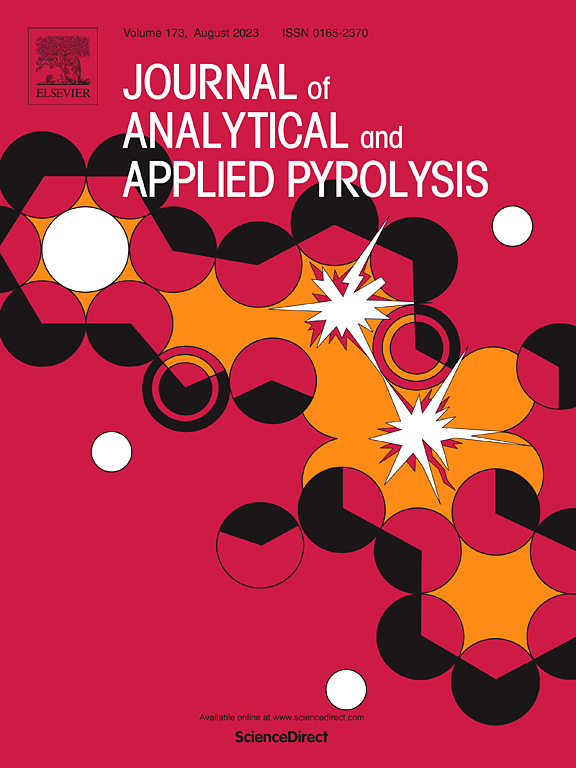热解和气相吸附相结合提高枣渣热解酸的质量
IF 6.2
2区 化学
Q1 CHEMISTRY, ANALYTICAL
引用次数: 0
摘要
千层树(cajuput)小枝生物质的热解产生的热解酸(PA)是一种生物活性液体,在食品和药品中具有潜在的应用前景。本研究研究了一种结合慢热解和气相吸附的综合工艺,利用来自同一生物质的生物炭来提高PA的质量。分析了原料生物质、生物炭吸附剂(天然吸附剂和盐酸活化吸附剂)的物理化学特性,以及所得的PA。气相吸附的整合通过增加乙酸和酚的含量显著改善了PA的组成,同时有效地减少焦油和多环芳烃(PAHs),特别是低到中等分子量的化合物。其中,PABA-1的乙酸含量最高(44.23 %),PABA-1的酚类含量最高(6.44 %),抗氧化性能较好。通过ABTS自由基清除实验评估抗氧化活性,发现PABA-1的IC50值最低(2190.07 ppm),表明高浓度酚类化合物增强了自由基清除能力。此外,抗菌实验表明,PA对金黄色葡萄球菌ATCC 25923(1.56 % MIC)和大肠杆菌ATCC 8739(3.12 % MIC)有很强的抑制作用,特别是对PABA-2。HCl对生物炭的活化进一步提高了其吸附性能,降低了焦油和多环芳烃的含量,同时丰富了有益的生物活性成分。这些发现强调了将热解和气相吸附相结合的方法在将PA升级为更安全、更多功能的天然防腐剂和生物活性剂方面的有效性。本文章由计算机程序翻译,如有差异,请以英文原文为准。
Integration of pyrolysis and gas phase adsorption to enhance the quality of pyroligneous acid from cajuput (Melaleuca leucadendron) residues
The pyrolysis of Melaleuca leucadendron (cajuput) twig biomass produces pyroligneous acid (PA), a bioactive liquid with potential applications in food and pharmaceuticals. This study investigates an integrated process combining slow pyrolysis and gas-phase adsorption using biochar derived from the same biomass to improve PA quality. The physicochemical characteristics of the raw biomass, biochar adsorbents (natural and HCl-activated), and resulting PA were analyzed. The integration of gas-phase adsorption significantly improved PA composition by increasing acetic acid and phenolic content while effectively reducing tar and polycyclic aromatic hydrocarbons (PAHs), especially those with low to medium molecular weight. Among the samples, PABN-1 produced the highest acetic acid content (44.23 %), while PABA-1 showed the highest phenolic content (6.44 %) and superior antioxidant performance. Antioxidant activity assessed through the ABTS radical scavenging assay, revealed that PABA-1 had the lowest IC50 value (2190.07 ppm), indicating enhanced radical scavenging capacity due to concentrated phenolic compounds. Furthermore, the antibacterial assay demonstrated strong inhibitory effects of PA against Staphylococcus aureus ATCC 25923 at 1.56 % MIC and Escherichia coli ATCC 8739 at 3.12 % MIC, particularly with PABA-2. The Activation of biochar with HCl further enhanced its adsorption performance by reducing tar and PAH content while enriching beneficial bioactive components. These findings highlight the effectiveness of integrating pyrolysis with gas-phase adsorption in upgrading PA for safer and more functional applications as a natural preservative and bioactive agent.
求助全文
通过发布文献求助,成功后即可免费获取论文全文。
去求助
来源期刊
CiteScore
9.10
自引率
11.70%
发文量
340
审稿时长
44 days
期刊介绍:
The Journal of Analytical and Applied Pyrolysis (JAAP) is devoted to the publication of papers dealing with innovative applications of pyrolysis processes, the characterization of products related to pyrolysis reactions, and investigations of reaction mechanism. To be considered by JAAP, a manuscript should present significant progress in these topics. The novelty must be satisfactorily argued in the cover letter. A manuscript with a cover letter to the editor not addressing the novelty is likely to be rejected without review.

 求助内容:
求助内容: 应助结果提醒方式:
应助结果提醒方式:


